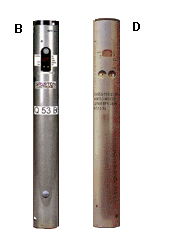


 The AN/SSQ-53D/E Directional Frequency Analysis and Recording (DIFAR) sonobuoy is an A-size, expendable and non-repairable sonobuoy. The DIFAR sonobuoy provides a magnetic bearing to the signal of interest to the monitoring unit(s) and can be used for search, detection, and classification. With this capability, it is possible to fix the location of a contact with as few as two AN/SSQ-53 sonobuoys. They are the buoy of choice, as they use a hydrophone with directional detection capabilities in the range of 10 Hz to 2,400 Hz as well as an omnidirectional hydrophone for general listening purposes.
The AN/SSQ-53D/E Directional Frequency Analysis and Recording (DIFAR) sonobuoy is an A-size, expendable and non-repairable sonobuoy. The DIFAR sonobuoy provides a magnetic bearing to the signal of interest to the monitoring unit(s) and can be used for search, detection, and classification. With this capability, it is possible to fix the location of a contact with as few as two AN/SSQ-53 sonobuoys. They are the buoy of choice, as they use a hydrophone with directional detection capabilities in the range of 10 Hz to 2,400 Hz as well as an omnidirectional hydrophone for general listening purposes.
The AN-SSQ-53B is fitted with microprocessor controlled EFS capabilities, with three depth selections [100, 400 or 1000 feet], three operating time selections of 1, 3 or 8 hours, and is 99 vhf channel selectable.
The AN/SSQ-53C has the same operating characteristics as the AN-SSQ-53B with a smaller housing length of 16.5 inches (�G� size).
The AN/SSQ-53D DIFAR, the current NATO production variant of the DIFAR sonobuoy, incorporates the Electronic Function Select (EFS) capability which provides the operator with the capability of electronically selecting one of the available 99 RF channels, sonobuoy life of one-half, one, two, four, or eight hours, and hydrophone depth of 90, 400, or 1000 feet. This modification represents a significant improvement of the AN/SSQ-53B, with a lower acoustic cut-off frequency 5 Hz reduced from 10 Hz. The AN/SSQ-53D also has improved suspension, wider sonic response curve, and electronic upgrades compared to previous DIFAR sonobuoys. The AN/SSQ-53E DIFAR sonobuoy incorporates Command Function Select (CFS). Through CFS, a suitably equipped ASW aircraft can transmit Ultra High Frequency (UHF) radio commands to the sonobuoy. These commands select Very High Frequency (VHF) operation (on/off), hydrophone reception (Constant Shallow Omni (CSO)/Normal, Automatic Gain Control (AGC) operation (on/off), and change RF channel frequency. The CSO is an omnidirectional hydrophone positioned at a depth setting of 45 feet. It is less sensitive than the normal DIFAR hydrophone, but is useful against an evasive submarine. AGC selection provides the operator additional flexibility when operating in a noisy environment. The ability to select VHF operation and change RF channels enhances operations in the littoral environment. Also, the AN/SSQ-53E includes an additional 200 feet EFS depth setting. The DIFAR, upon self-activation, operates in a passive mode at the preset life and depth. Upon reception of acoustical signals, the subsurface unit converts the pressure waves into amplified electronic signals and provides a magnetic reference for each signal through utilization of the flux gate compass. These signals are sent to the surface unit via the cable assembly. The surface unit applies these signals to a preset Frequency Modulation (FM) carrier for VHF transmission. The monitoring platform receives the signals for recording, processing, and analysis.